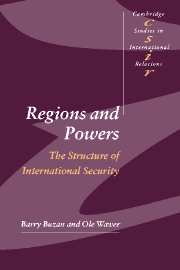Book contents
- Frontmatter
- Contents
- List of illustrations
- Preface
- List of abbreviations
- 1 Patterns of regional security during the Cold War
- 2 Patterns of regional security post-Cold War
- Part I Introduction: developing a regional approach to global security
- Part II Asia
- Part III The Middle East and Africa
- Introduction
- 7 The Middle East: a perennial conflict formation
- 8 Sub-Saharan Africa: security dynamics in a setting of weak and failed states
- Conclusions
- Part IV The Americas
- Part V The Europes
- Part VI Conclusions
- Glossary
- References
- News media
- Index of names
- General Index
- CAMBRIDGE STUDIES IN INTERNATIONAL RELATIONS
7 - The Middle East: a perennial conflict formation
Published online by Cambridge University Press: 05 December 2009
- Frontmatter
- Contents
- List of illustrations
- Preface
- List of abbreviations
- 1 Patterns of regional security during the Cold War
- 2 Patterns of regional security post-Cold War
- Part I Introduction: developing a regional approach to global security
- Part II Asia
- Part III The Middle East and Africa
- Introduction
- 7 The Middle East: a perennial conflict formation
- 8 Sub-Saharan Africa: security dynamics in a setting of weak and failed states
- Conclusions
- Part IV The Americas
- Part V The Europes
- Part VI Conclusions
- Glossary
- References
- News media
- Index of names
- General Index
- CAMBRIDGE STUDIES IN INTERNATIONAL RELATIONS
Summary
Introduction
The Middle East is a place where an autonomous regional level of security has operated strongly for several decades, despite continuous and heavy impositions from the global level. Its RSC is a clear example of a conflict formation, if one that is unusually large and complicated, and that also possesses some distinctive cultural features. As in many other places in the third world, the insecurity of ruling elites within their domestic sphere plays a significant role in shaping the dynamics of (in)security overall. On the surface, this is a region composed largely of postcolonial modern states, albeit mostly weak ones. But this structure is riddled with still powerful premodern elements of clan, tribe, and religion. Definitions of the Middle East vary, but we see a pattern of security interdependence that covers a region stretching from Morocco to Iran, including all of the Arab states plus Israel and Iran. Cyprus, Sudan, and the Horn are not part of it. Afghanistan is an insulator between it and South Asia, and Turkey between it and Europe. Turkey's insulating function was enhanced by the fact that, although it had once ruled much of the Arab world (as the heartland of the Ottoman Empire), from the 1920s onwards it largely turned its back on this past in order to pursue Ataturk's Westernistic vision of its future.
- Type
- Chapter
- Information
- Regions and PowersThe Structure of International Security, pp. 187 - 218Publisher: Cambridge University PressPrint publication year: 2003

